The dozen or so releases on the Miranda label are not often found on the want lists of modern day collectors. The vocal / orchestral style captured on H.I. Miranda’s eponymous label has fallen from favor with the current collecting public, but it is important to give a nod to the pioneering label and contributions of Miranda to Lexington’s musical past. [2019 Shawn Chambers / Lexingtunes]
The early family life and upbringing of Heber I. Miranda are lost to the fog of history. He was born November 26, 1906 in Ashland, Kentucky, to David Miranda and Carlie Cumeens. In September of 1923 the not yet 17-year-old apparently eloped with Josephine Dailey and was married in Clark County, Indiana. The circumstances can only be guessed at, but both bride and groom added several years to their true ages by listing birth years of 1901. H.I. noted both parents as “deceased” on his marriage license application and stated his occupation as “painter”. Their first child, William, arrived in 1924.
By 1940, the Miranda’s were working together in shoe sales. The family had continued to grow with the addition of two girls (Doris and Karra Esther) and H.I. was surely looking for opportunities to better his family’s station in life. He made business and political contacts at every opportunity.
The Kentucky Sesquicentennial Committee had formed in 1937 to prepare for a statewide celebration coming in 1942 to mark Kentucky’s 150th year of statehood. A natural salesman, H.I. Miranda signed on as a Publicity Director to sell memberships locally in the Sesquicentennial Association. When a key committee member resigned in late 1941 Miranda was appointed Executive Director. It was during the committee years that Miranda met and befriended two important Kentucky politicians: Alben Barkley and A.B. “Happy” Chandler.
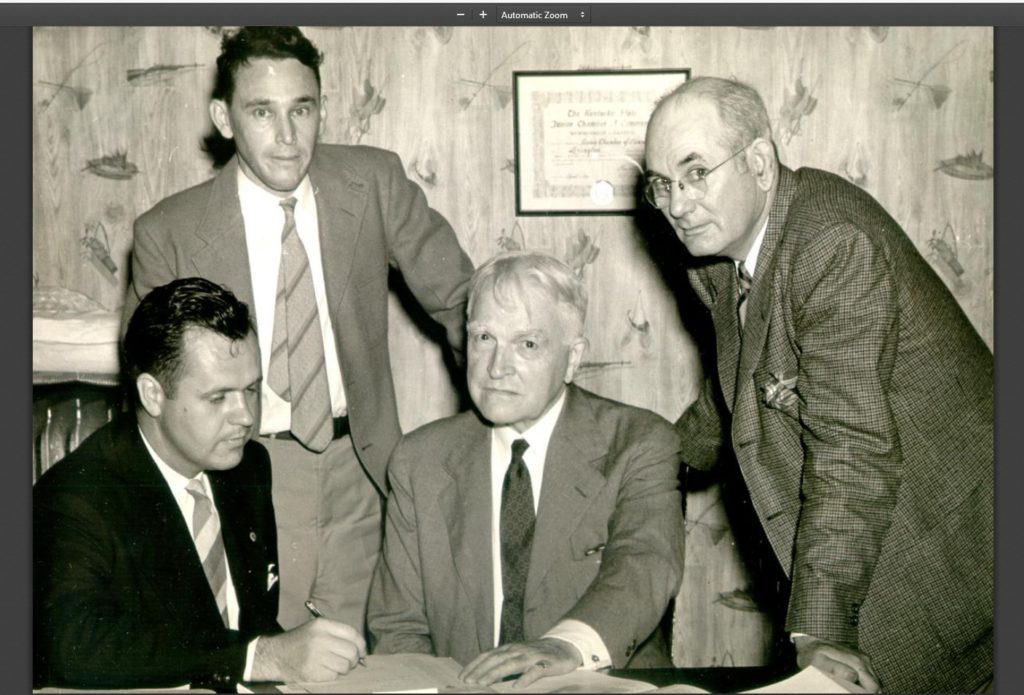
Beyond the home front, World War II raged in Europe and the United States’ official entry by 1942 heralded in a booming wartime economy. H.I. with family in tow relocated to Lexington and by ’43 or ’44 he was working at the newly built Lexington Signal Depot in Avon in a public relations role. This would ultimately be short employment that wound down with the surrender of Japan and Germany.
H.I. transitioned back to the private sector and business sales. He was Vice President of KY Building and Sales in 1947 before shifting into a long career working for Fowler Skylight Company – first as Vice President, but ultimately as President and Owner. He still had several other irons in the fire.
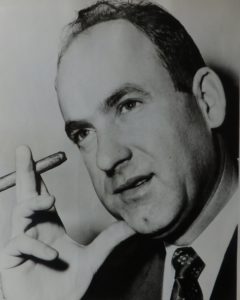
In 1950 Miranda attempted to establish a Major League Baseball Player’s Union. His friend, “Happy” Chandler was now the Commissioner of Baseball and Miranda made every effort to garner his support. It was a serious attempt with Miranda opening a temporary office in Cincinnati and speaking to anyone that would listen. Chandler was battling unhappy team owners for a contract extension and ultimately resigned in mid-1951. This quashed H.I.’s hopes and the Union was abandoned.
There was happiness in the Miranda household despite the MLB setback. His youngest daughter, Karra Esther, had married and was spending much of her time on songwriting. H.I. sensed a new opportunity and despite no experience in the music industry decided to make a foray into the business.
There was little competition in Lexington in 1955 when H.I. officially launched his label. Bob Mooney had issued a couple 45s on his Fayette label, but his future REM label success was still several years away. Miranda Records would be the first REAL label in town and H.I. certainly intended to do it right.
He secured the Ben Ali Theater for a record release / listening party in October of 1955. The debut single available as both a 78 and 45 would be from Lambsie Penn a Miranda “discovery”. Penn hailed from the Danville, Virginia, area and was managed by her father, Richard. This initial waxing would be a true family affair as the two songs “Ootsie Bootsie Cootsie” and “How Could I Fall For You” were both written by Karra Esther Beam. Local reviews were favorable and “Little Miss Show Business” gushed the baby talk A-side lyrics with sincerity. 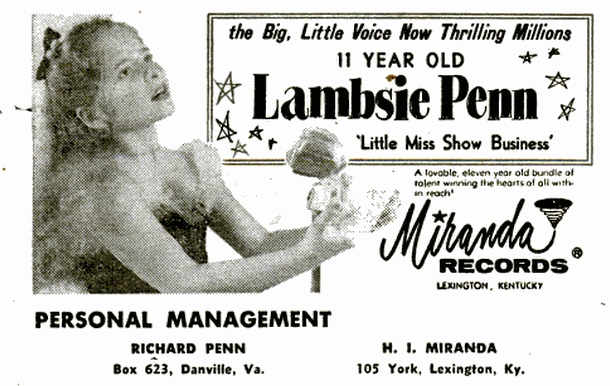
The youngster was backed by the Stu Bruner Band on the single. A Kentucky native, Bruner was a solid veteran of the industry having manned the saxophone behind Jan Garber and worked on dozens of Harry James’ Columbia Recordings. Clearly some serious money and effort was put into this release.
The sophomore issue (“I Know You Belong to Someone Else” / “Hard Hearted Hannah”) was similar in nature – Lambsie Penn again backed by Stu Bruner. This release was hot on the heels of the first and clearly Miranda had it in the can as Billboard reviewed this second release in the October ’55 issue. “Hannah” was an old song with lyrics far better suited to a Mae West type than Little Lambsie. Billboard felt the same. The review praised the work of Bruner, but the rag overall disparaged the release calling the B-side a “highly inappropriate performance by the 11-year-old thrush” and the A-side a “thoroly (sic) misguided effort.”
The senior Penn and Miranda obviously were hoping for some novelty value in these recordings, but just missed the mark. But despite the lack of success on Miranda’s label, the world would hear from Florence “Lambsie” Penn again. She made a minor splash on Atco with a true novelty song “I Wanna Spend Xmas with Elvis” penned by Don Kirschner and Bobby Darin. Penn hiccups with abandon in true rockabilly style and the record has enjoyed a long life thanks to Christmas record and Elvis record collectors. She was also redeemed in Billboard with a very favorable review.
During the same time, Miranda began his association with the man who essentially became the face of the label: Arthur Lee Simpkins. Sadly, Simpkins is known only to ardent music fans today, but was once one of the most popular African-American pop singers in the country. Raised in Augusta, Georgia, the multi-talented Simpkins was a star of stage and screen. Dubbed “the Black Caruso” his smooth tenor voice carried him to clubs throughout the land. His ability to sing in six languages and easy interaction with the audience made him a crowd favorite. He was particularly popular in Chicago, Las Vegas, California, and enjoyed appearing at the Beverly Hills Country Club (later Supper Club) in Southgate Kentucky where he sang for more than a decade. It is likely that the Beverly is where Miranda offered his label’s services to Simpkins.
Arthur Lee was nearing age 50 and skeptics may consider it akin to a club signing a washed up ballplayer, but Simpkins was anything but. He was guest on Jackie Gleason’s “Cavalcade of Stars” in ’51 and appeared in a Hollywood movie “Camp Jamboree” in ’53 while continuously touring as a singer. Beyond the Miranda years he would appear on the Jack Paar show, multiple times on Ruth Lyons’ “50-50 Club” and be one of the few singers invited to perform at Sam Cooke’s funeral.
The output for Simpkins on the Miranda label showed real effort. In addition to the roughly half dozen singles (at least one with a picture sleeve), Simpkins enjoyed two full length LPs on the label – including an early Stereo release of his initial waxing. Regardless of packaging presentation, it is, of course, the songs that sell records and the releases were a mixed bag. Simpkins soars on classics like “I Believe” and “Down By The Riverside.” However, for every success there was a lesser cut. Invariably critics would downgrade songs penned by Esther or H.I. himself (as in the case of his lyrical tribute to his friend Alben Barkley).
Sales numbers are virtually unknown, but there was serious promotion and by contemporary accounts it is likely that the LPs at least sold several thousand copies in the region. Miranda had recruited Ike Klayman for distribution in Cincinnati and hit the highway himself with trips to Chicago, St Louis, Cleveland, and Memphis to promote Simpkins’ release “I Resolve”. Any chance H.I. had to recruit a distributor he did.
The label’s 105 York Street address was the location of his skylight business and it seemed to be occupying more of his time. Releases were spread further apart. Towards 1960 as Miranda moved past releasing Arthur Lee Simpkins records, there were now other labels up and running in Lexington – most notably the second effort by Bob Mooney and his newly launched REM label. There were also plenty of local musicians and singers to choose from and even some that seem a good fit for the label (the great Duke Madison and his combo for example), but it was not to be.
The only sample of local “talent” was the H.I. Miranda penned sides that he coaxed “Happy” Chandler into recording in 1966. The coaxing would have been minimal as Chandler was known to spontaneously burst into song at many political gatherings. His release with a picture sleeve speaks to his popularity locally as it remains one of the easiest Miranda releases to find. The cut “Roses in December” was directly influenced by a phrase in a Chandler speech from 1959, while the flip “Come Back to Your Kentucky” layers Chandler’s folksy delivery over a chorus and horns.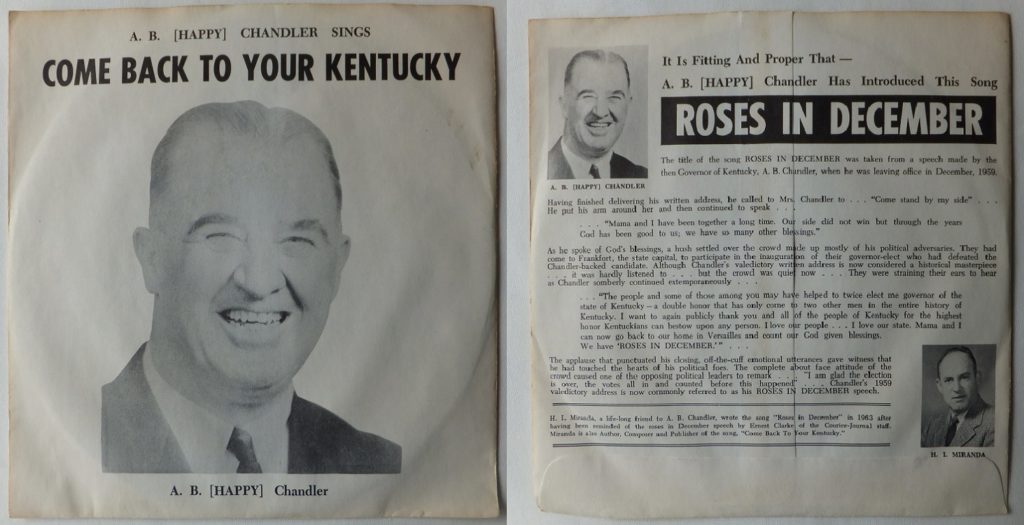
H.I. Miranda was proud of the two cuts, obviously, as he quickly recruited veteran vocalist Russ Carlyle to give them a polished jazzy vocal and released them both as A-sides with the B-sides being songs originally penned by his daughter Esther. The time for the label was drawing to a close, however.
The Miranda’s had relocated to 401 Dudley Road and H.I. was having health issues. Like a quarter century before as sales clerks, husband and wife were now working together again with Josephine holding the title of Vice President of the business. At a time when many men would be considering retirement, Miranda hustled on. In addition to the glass business he was President of the Boone County Tobacco Warehouse in Florence. Beyond work, he was a grandfather, 32nd degree Mason and Oleika Shriner.
H.I. Miranda died on October 9, 1973.
DISCOGRAPHY
Presented below is what I believe to be the complete Miranda discography with the 45s in the order I perceive them to have been released. More specific information (especially artist credits which have been shortened for brevity’s sake) may be found in the label shots. Click label shot to enlarge.
45
Lambsie Penn 4-55-1 / 4-55-2 Ootsie Bootsie Cootsie / How Could I Fall For You 1955
EB matrix Capitol Custom press
Lambsie Penn 4-55-3 / 4-55-4 I Know You Belong To Someone Else / Hard Hearted Hannah 1955
EB matrix Capitol Custom press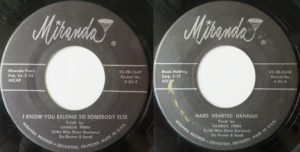
Arthur Lee Simpkins 4-55-5 / 4-55-6 I Wonder, I Wonder (Does He Live With A Broken Heart) / Marie 1955
EB matrix Capitol Custom press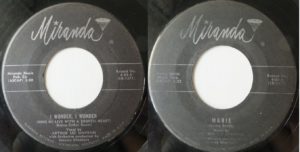
Arthur Lee Simpkins 4-66-7 / 4-66-8 This Is The Real Thing / Them There Eyes 1955
Note: I believe this number to be a label misprint and believe it was meant to be 4-56-7 / 4-56-8. This single reviewed in Billboard early March 1956 which would support a “56” record number as H.I. was fairly consistent in his numbering. He was probably opting for a 1956 release and it seems he may have held this one back. This also has an EB matrix Capitol Custom press which would imply 1955 stamping. Dating based on matrix.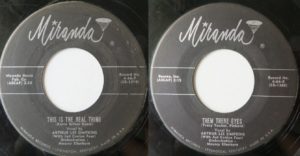
Arthur Lee Simpkins 4-56-9 / 4-56-10 Everytime I Feel The Spirit / Down By The Riverside 1955
Note: similar to above the “56” number would imply 1956, but also has EB matrix Capitol Custom. Believe it was pressed in ’55 and held by H.I. until ’56 for release.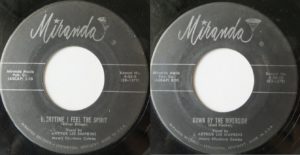
Arthur Lee Simpkins 4-56-11 / 4-56-12 Diane / My Fate 1955
Note: same as above – appears pressed in ’55 but held.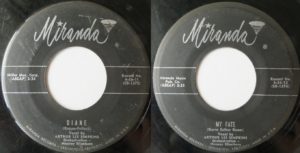
Arthur Lee Simpkins 4-56-13 / 4-56-14 I Resolve / I Long For You 1956
FB matrix Capitol Custom Press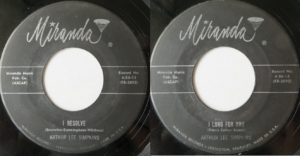
Arthur Lee Simpkins 4-57-15 / 4-57-16 Ballad Of Alvin Barkley (I’d Rather Be A Servant In The House Of The Lord) / For Old Times Sake 1957
GB matrix Capitol Custom – label misprint – name is “Alben” – Barkley died in 1956. This tribute incorporates his famous quote “I would rather be a servant in the house of the Lord than to sit in the seats of the mighty.”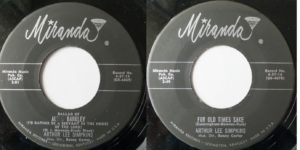
Arthur Lee Simpkins 91960 / 91961 Shine Miss Liberty Shine / I Believe 1960
reviewed Jan 1961 Billboard – based on numbering scheme and allowing for pressing plant time and shipment to review would be 1960. Also came with a picture sleeve.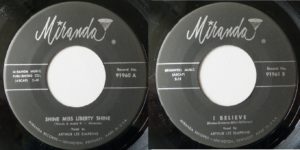
Miranda Records Studio Band and Chorus 6212 Patch Up The Crack (In The Liberty Bell) Let Freedom Ring / Shine, Miss Liberty, Shine 1962?
Note: believe this to be 1962. Song has Library of Congress copyright from second half of ’62 and Miranda is fairly consistent using year in the number. Also appears in ’63 copyright catalog.
A.B. (Happy) Chandler 666 Come Back To Your Kentucky / Roses In December 1966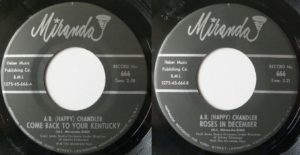
Russ Carlyle 671 Come Back To Your Kentucky / This Is The Real Thing 1967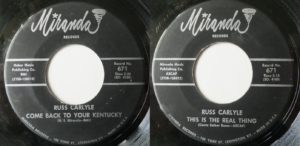
Russ Carlyle 672 Roses In December / I Wonder, I Wonder 1967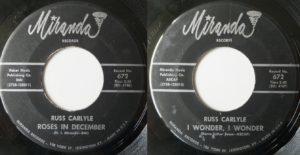
Arthur Lee Simpkins / The Miranda Singers 1972 / 1976 Bless This House / Let Freedom Ring 197-
This last single dedicated to the late great Simpkins as well as the US Bicentennial so possibly released by Miranda’s estate in ’76 or he released it in ’72 or ’73 following the death of Simpkins with a pre-emptive dedication to the Bicentennial.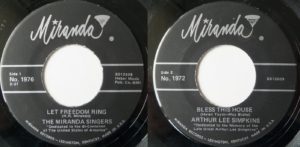
78
Lambsie Penn 7-55-1 / 7-55-2 Ootsie Bootsie Cootsie / How Could I Fall For You 1955
Note: this is the only 78 I have ever seen or owned. Possibly other of the early releases exist on 78 as well.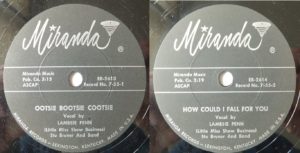
LP
Arthur Lee Simpkins 5657 The Magnificent Voice Of Arthur Lee Simpkins 1956 or 1957
Cover shows Simpkins-1917 while the vinyl label reads “Album #5657” based on various statements encountered ’56 or ’57 seems very likely as release date.
Arthur Lee Simpkins 6106 Let’s Go To The Beverly 1961
Factory Sleeve: 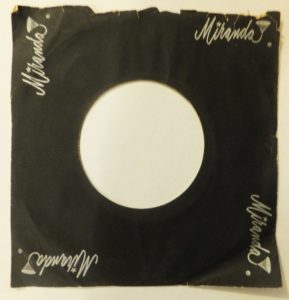
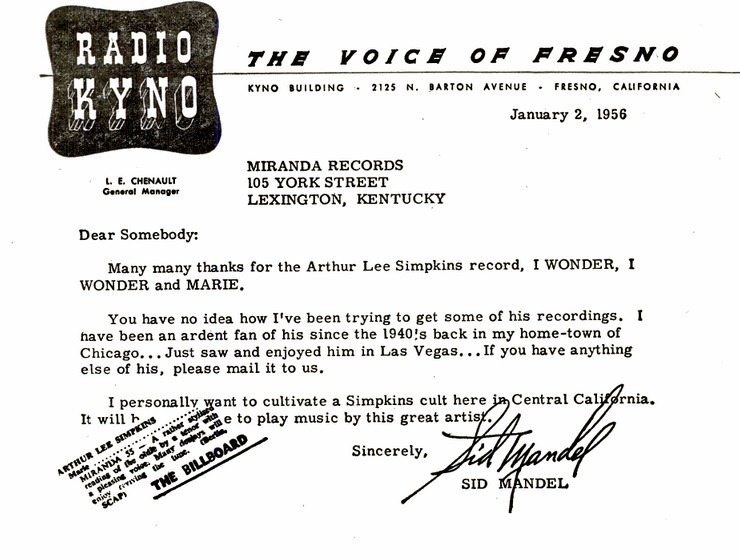
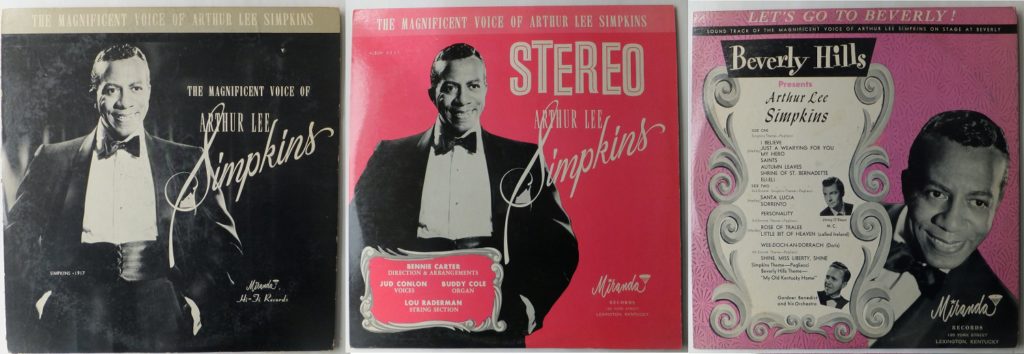
This is HI Miranda’s grandson (Karra Esther Miranda’s son) David Beam Jr. Thank you for your research and article
David, H.I. was really a pioneering figure in the Lexington music scene and I’m glad you found my piece on him. Thanks for taking the time to comment.
Im his grandaughter Daves sister….Thank you for this arcticle and recognition ! He was quite a man!